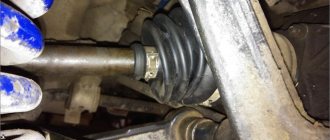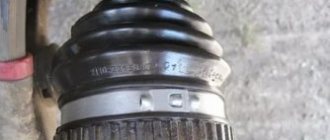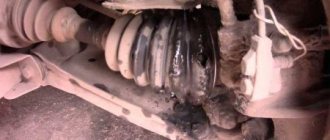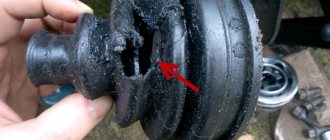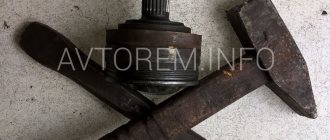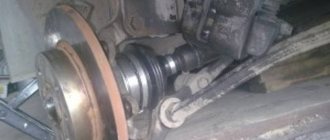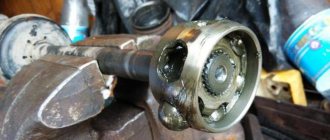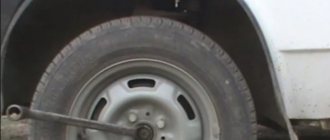As for the VAZ-2109, this model has two CV joints: external and internal.
And today we will talk about how to replace the outer boot for a given car with your own hands, since it is this that most often becomes deformed and torn.
How to check the condition of the anthers yourself
This procedure is very simple and does not require special skills. A visual inspection for breaks, cracks and lubricant leaks is sufficient. To do this, you need to turn the front wheels of the car in either direction and carefully inspect the rubber dust covers.
If any damage or lubricant leakage is detected, the covers must be changed as soon as possible.
Otherwise, the drive shaft (CV joint) of the car will quickly fail.
This is interesting: How to properly charge a car battery with a charger
Which CV joint boot is better to install on VAZ 2110-2109, 2110
First of all, the outer boot must be suitable in size if we are not buying an original one, but an analogue. The dimensions of the VAZ boot are as follows:
It is also important to pay attention to the material from which the boot is made. Silicone work well , they are easy to distinguish by their softness, they are often made of unpainted silicone, translucent.
Types of anthers on CV joints and their main weak points
Polyurethane anthers on VAZ are a rather controversial thing. On the one hand, polyurethane is a durable and tear-resistant material. On the other hand, in severe frost they can harden so much that there is a risk of rupture right on the move. It all depends on the composition of the polymer.
rubber boots is also ambiguous, since rubber is different from rubber. If we choose this option, it is better to start with a brand that we trust. And a little about brands.
NTN-SNR, France
Definitely recommended for purchase. Made of polyester (PEEST marking), it has an interesting design feature - fillets are made between the corrugations to remove the load from a specific corrugation and distribute it evenly over the entire surface. The catalog number is the same as that of the branded VAZ boot - 2108-2215030. The resource is more than 150 thousand km , it is not afraid of frost and high temperatures.
HORS, RF
Sold in branded packaging, made of red-painted silicone. The packaging indicates a 1-year warranty; it responds well to severe frosts, but the total resource does not exceed 8-10 thousand km , depending on operating conditions. 2108-2215036 is indicated on the case body .
TRACK, country of origin unknown
Made of transparent silicone, packaged in a blister with a sticker stating a one-year or 40 thousand km warranty. It is absolutely not afraid of frost, it will last more than 50,000 km , if it is not a fake. The specified catalog number is 2110-2215030.
BRT, RF
Made of black material, chloroprene rubber. Indifferent to frost, service life at least 40,000 km . Sold without packaging, all information is embossed on the case, catalog number 2110-2215030 .
Trialli RG 0130, Russian Federation
Made of black chloroprene rubber, packaged in a bag with a sticker, logo and factory catalog number 2108-2215030. Judging by the reviews, it has performed well, is not inclined to become dull in the cold, users estimate the average resource to be within 30-40 thousand km .
TSN 3.2.1, China
It makes no sense for replacement, since the resource under normal conditions is no more than 2,000 km. True, it is sold complete with good clamps and lubricant for the CV joint. Marked with serial number 2108-2215030.
There are also a number of domestic and Chinese anthers that correspond to the factory catalog numbers, but you can buy them at your own peril and risk if you do not trust the VAZ cover.
Shall we get started?
Before replacing the mechanism, you need to drain all the oil from the gearbox. Let's not touch the jack yet! You need to place a brick under the rear wheel of the car, after this procedure we take the 30 socket and, accordingly, loosen the nut. Don't be alarmed, you may need about a half meter long piece of pipe half a meter long as a lever. Remember, we only need to loosen the nut, not remove it yet!- Everything worked out? Go ahead! We lift the car with a jack, and only now completely remove the hub nut along with the washer. Now you can safely remove the wheel from the hub.
- Take the 13mm head and remove the two bolts that secure the ball to the hub. After this, we move the hub and remove the outer grenade from it. Then we attach a pry bar to the internal grenade and, using hammer blows, knock it out of the gearbox. By the way, if you still don’t have a pry bar at hand, a piece of pipe can replace it.
- When the grenade is removed, we clamp its shaft in a vice.
- We remove the clamps from the unusable boot. After that, we shoot down the outer grenade. Attention! In order not to damage it, you need to hit it along the edge. When this operation is completed, remove all old grease from the mechanism, wash it in gasoline or kerosene and wipe it well again, this way you can better remove traces of grease.
- Now we put a new boot on the drive shaft, and using a hammer we hammer the outer CV joint back, after thoroughly lubricating all the parts of the product. After that, we put it on and tighten it with a collar.
- Then we insert the grenade into the gearbox, driving it there. We place it in the hub and return the ball to its place. We put on the hub nut.
Attention! The hub nut does not need to be tightened with great force. After installing the wheels, tighten the bolts without applying much physical force.
- We remove the car from the jack, place a brick under the front wheel and tighten the nuts tightly.
- Well, now pour oil into the gearbox.
That's all. Congratulations! Replacing the boot on the VAZ-2109 is complete!
Causes and breakdowns
In reality, the resource of the CV joint turns out to be significantly less, which is caused by operating conditions, poor quality of roads, driving habits and other factors.
People usually call a CV joint a “grenade,” which is due to the external similarity of the element to this explosive device.
Here's what you should know about grenade malfunctions:
- Practice shows that the most common cause of CV joint failure is dirt, dust, and sand that enter the mechanism through a damaged boot;
- Sometimes the problem of a non-functioning grenade can be solved by replacing the boot. This is possible if the CV joint itself has not yet worn out due to exposure to contamination;
- If the damaged boot is not detected in time, the grenade will be completely worn out within literally 200 kilometers;
- If the CV joint fails, a strong crunching sound appears when cornering and accelerating. Such a symptom indicates the need to urgently replace the CV joint;
- The cost of new grenades is quite affordable; they are available at any auto parts store. But you should purchase those that meet the technical requirements of the VAZ 2109;
- If you have at least a little experience in repairing cars yourself, it is quite possible to replace a grenade with your own hands.
Old and new element
Drive shaft assembly process:
- take a new dust cover and put it on the shaft;
- we drive the CV joint onto the splines, after filling it with new lubricant;
- put the boot on the bearing and tighten the clamps;
- We install a plastic plug at the end of the inner CV joint shaft;
- Before mounting the drive in place, install a new retaining ring on the inside of the drive shaft;
- insert and snap the shaft into the gearbox by lightly tapping the shaft with a hammer, preferably through the spacer;
- We insert the outer side of the drive shaft into the splined joint of the hub. We put on the thrust washer;
- be sure to install a new hub nut;
- tighten the nut tightly. If you have a torque wrench, the tightening force should be 25 kg/cm;
- We tighten the nut with a chisel, jamming its edge. To prevent spontaneous unscrewing of the nut;
- reinstall the protective cap of the hub nut;
We carry out the entire procedure for replacing CV joint boots on a VAZ-2109 on the other side of the car, in the same sequence.
After installing the drives, you need to check the reliability of the connections by holding the drive with your hand and shaking it in different directions. In this case, no backlash should appear. Also, play is unacceptable in hub bearings. The wheel should rotate freely, without any difficulty.
With timely detection of defects and replacement of boots, the service life of components and drive mechanisms of your car increases.
Detailed video instructions:
Constant velocity joints
We all know that modern cars often use types of wheel drives using constant velocity joints.
These joints, abbreviated as CV joints, are installed on all cars with front-wheel drive, as well as on the front axle of SUVs.
Having a fairly good service life, CV joints still have one significant drawback - they are highly sensitive to contamination.
If sand, dust, or water gets inside this hinge, it leads to rapid wear of its components.
To prevent contamination, the internal elements of the CV joint are covered with a boot.
However, it is made of rubber, so it is not particularly difficult to damage it, and over time, the boot simply cracks due to exposure to external conditions.
The appearance of cracks in the boot is unacceptable, otherwise dirt will soon get into the joint, which will lead to irreversible consequences, and eventually it will have to be replaced.
Since there are two CV joints installed on each drive shaft, and therefore two boots, their condition should be periodically inspected to identify damage.
More often, of course, this element is damaged from the outside, since it is located near the hub.
But replacing it and washing the external hinge is somewhat easier due to easier accessibility to it.
The internal anthers are located near the box and are more difficult to damage, but servicing the hinge is also labor-intensive.
In the future, we will consider the sequence of actions for changing the boot of the internal CV joint of several cars.
Types of CV joints
Before you begin repairs, you need to find out exactly how the unit is designed.
The pair of drives on the VAZ 2109 is equipped with a total of 4 CV joints.
| CV joint type | Peculiarities |
| Interior | There are 2 of them. They transmit torque to the axle shaft from the gearbox |
| Outer | There are also two of them. Installed on the ends of the axle shafts and transmit torque directly to the wheels |
External
This arrangement of grenades ensures the possibility of wheel rotation during turns and constant operation of the suspension system. To put it simply, the outer CV joints are responsible for transmitting torque when cornering, and the inner ones are responsible for the vertical movement of the wheels. These are collisions with bumps, holes, roll in turns, etc.
Interior
This is interesting: How much does 1 liter of gasoline 92 weigh?
Preparation
So, damage to the boot on the VAZ 2199 has been identified. You can replace it and wash the CV joint itself in the garage, the main thing is that there is an inspection hole.
Tools you will need:
- Set of wrenches (socket wrenches, open-end wrenches);
- Set of heads and collars;
- Metal brush;
- WD-40;
- Mount;
- Hammer;
- Jack;
- Wheel chocks;
- Wooden coasters.
You will also need a new boot, CV joint grease-4, a container for collecting oil, a container with gasoline for washing the CV joint, and rags.
It is better to do all work together with an assistant.
For convenience, we will describe the process of replacing the external boot on the left side. The replacement work on the right side is identical.
Asia-Pacific
Country of origin: Russia
The boot has a brand name and marking 2110-2215030-01. Material specified >GR CR CR TE (PEEST) 9998
CV joint on VAZ 2114: replacement without problems
Replacing the CV joint on a VAZ 2114 is done after diagnosing its malfunction. Typically, this unit reliably serves for 100 thousand kilometers. The CV joint can fail earlier if the owner of the car does not look after the integrity of its boots and does not change them in time. Then, through cracks or breaks, a lot of dirt gets into the hinge mechanism, as a result of which the unit very quickly becomes unusable. Signs of a faulty part are a knocking and crunching sound when the front wheels turn in any direction.
An operation such as replacing a CV joint on a VAZ 2110-14 does not take much time. To perform this, you need to install the car on an inspection hole or overpass. You need to place boots under the rear wheel, located at an angle from the one being removed. If there is poor lighting in the inspection ditch, then an LED flashlight, which can be attached to the head using a strap, will not hurt. This will free up both hands for work. Here is a list of other tools for performing substitution:
- a set of spanners or sockets;
- pliers;
- hammer;
- puller for pressing out the ball stud;
- vice;
- wheel wrench and jack;
- screwdriver;
- thick lubricant “CV joint-4”;
- rags.
The extractor for extrusion is an iron cup with a side groove and a threaded rod for extrusion. A fairly common device, it can be found on many car owners.
